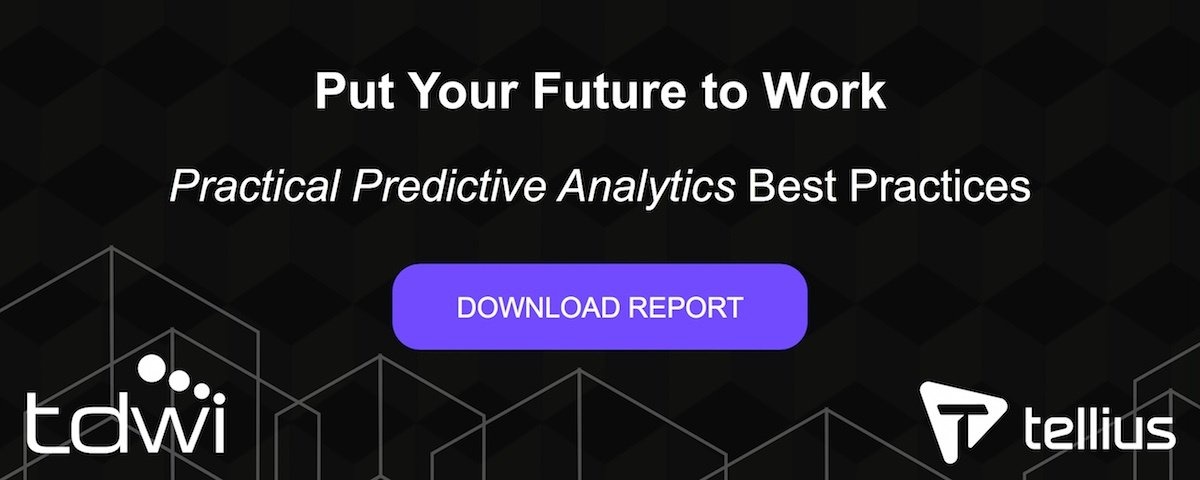
Every year industry analysts proclaim that the coming year as the year that predictive analytics will finally make it’s big splash. And for good reason. Not only have the many use cases for predictive analytics become crystal clear, some organizations are well into their journey to gaining return on their data science investments. For instance, the widespread utilization of predictive analytics can play a key role in:
- Understanding customer behavior to the point organizations can predict product and service needs
- Gaining insights into predictive maintenance, such as the ability to replace crucial parts before a piece of equipment breaks down
- Building dynamic pricing models within digital environments
- Recognizing and putting an end to fraudulent activity within heavily regulated environments laden with personal data
- Helping determine the risk of reinfection or readmittance within a healthcare environment
And yet, according to the TWDI Best Practices Report: Practical Predictive Analytics, many organizations are struggling in their efforts to produce the desired business outcomes. They found three main issues that keep the adoption of predictive analytics at only 35% of the organizations they surveyed. Specifically, they identified a shortage of skilled professionals, a lack of executive and organizational support, and data infrastructure issues as the primary challenges holding organizations back from fully realizing the potential of predictive analytics.
McKinsey’s research confirms these findings – spotlighting a shortage of 1.5 million managers and analysts with the skills to understand and make decisions based on the analysis of big data.
The question is: what steps can organizations take today to move beyond these challenges, and truly kickstart the adoption of predictive analytics?
In This Post
1. Bridge the gap between data science output and business consumption.
For many companies, data science activity is far too disjointed and tends to have a sense of mystic surrounding the insights. This happens because the “magic” often happens far away from actual business operations. As such, when the business has a hard problem it wants to solve using data, the leadership team asks the data science professionals to investigate. And, when the data team eventually comes back with an answer (often weeks sometimes months later), it surfaces as a separate report or output that far too often remains completely different from what the business can easily consume. As a result, the insight, although comprehensive and meaningful, rarely translates into difference-making action.
One way to bridge this gap with Tellius is to build predictive models and give the business the ability to access and explore the recommendations generated by the models through interactive visualization. Users will find all their operational dashboards and their predictive insights in one place.
Another way to bridge the gap is to embed the predictive insights directly in the business applications that users prefer. Tellius allows interactive visualizations to be embedded into external applications. And with the Tellius Predict API, external applications can retrieve recommendations from the predictive models. As a result, those who can actually make use of the insights have access to real-time predictions, directly within their everyday workflow. This is much more efficient that disjointed reports.
2. Grow the population of citizen data scientists with automated machine learning.
Building predictive models does not need to be a task that is performed only inside the hardcore data science silo. After all, there are many answers to complex questions that businesses can benefit from without requiring the .01% level of optimization that data scientists seek. Even non-technical users can leverage automated discovery of insights to surface important findings hidden in their business data, including anomalies, correlations, and segments in order to quickly enhance business performance.
Emerging citizen data scientists can also benefit from automated training of machine learning models. Users select one or a class of models to train, tune, and evaluate. Coding is not required, so a conceptual understanding of machine learning is all that is required. Automated machine learning is a huge step in growing the data literacy and advancing the analytics maturity within an organization. The Tellius platform has both automated discovery of insights and automated machine learning.
This InformationWeek article provides some great insights into effectively harnessing the talents of the citizen data scientist population. “Not everyone in an organization will become a citizen data scientist — at least by Gartner’s definition. By that standard citizen data scientists are power users. The new role does not threaten those of data scientists, data analysts, or business analysts; it complements them. And in fact, citizen data scientists necessarily have to work with other roles to derive the most value from analytics.”
3. Collaborate in systems that support both BI and AI capabilities.
Fortunately, according to the recent Forrester Research report, “Predictions 2018: The Honeymoon For AI Is Over,” the move towards fully embracing and integrating AI is gaining steam moving it beyond trend status. Specifically, 70 percent of enterprises expect to implement AI within the calendar year, up from 40 percent in 2016 and 51 percent in 2017.
Routinely, data scientists use a separate set of technologies when compared to the business, who are used to traditional business intelligence dashboards – these two populations even use different words to describe the same things. So to bridge the gap and increase collaboration, Tellius supports both business intelligence and data science initiatives. This means that everyone has access to a common set of data and data preparation capabilities, which cuts down on the need for multiple processes to retrieve data from the source and to cleanse data. This also makes it easier for everyone to collaborate during the model building, validation, and operationalization process, which then accelerates the iterations to take predictive insights to production.
Yes, the adoption of predictive analytics is at an inflection point. But more importantly, let’s get past the over-hyped expectations so you can focus on attaining the practical benefits in a pragmatic way.




